Content
1、Similarities Between A Chef’s Knife And A Santoku Knife
2、Differences Between A Chef’s Knife And A Santoku Knife
3、What is a Chef’s Knife?
- Main Features Of A Chef’s Knife
4、What is a Santoku Knife?
- Main Features Of A Santoku Knife
5、How They Serve Your Cutting Needs
- Chef’s knife best used for?
- Santoku best used for?
6、Best Chef’s Knives and Santoku Knives To Buy
7、Frequently Asked Questions About Chef’s Knives And Santoku Knives

A Rundown : Chef’s Knife vs. Santoku Knife
1、Similarities Between A Chef’s Knife And A Santoku Knife
In the culinary world, there are two types of chef knives that serve as multipurpose tools in the kitchen: the classic Western-style chef’s knife and the Japanese-style Santoku knife.
They are both designed to be kitchen essentials -- the ‘go-to’ knives for many professional chefs and cooks and food lovers as they are versatile enough to fulfill a range of kitchen tasks in both the professional and home kitchen.Both Santoku knives and chef’s knives are multi-purpose, wide-bladed cutting utensils used for slicing, dicing and chopping,and can often be seen side by side on the chopping board.
The both blades can each be made of a variety of different materials, such as ceramic or metal,with a thin sharp edge that’s kept at an acute angle to slice through various ingredients.Though most home and professional cooks prefer a steel kitchen knife for its durability,resilient and performance.The handle materials range from hard plastic to wood to stainless steel. Some knives have a bolster to protect your fingers during the chopping and slicing,while others have ergonomic handles for a more comfortable grip.

2、Differences Between A Chef’s Knife And A Santoku Knife
As the most popular versatile kitchen knives, both the Chef’s knife and Santoku knife can be used for a range of meal prepping tasks, could fulfill your daily kitchen tasks and would give you a joyful experience when you make every cutting, slicing, mincing and chopping.
However,not all types of multi-purpose knives are the same, of course,some of them differ greatly from each other in the way they accomplish these tasks, in their construction and in their origins.A Santoku knife is different from a chef’s knife in material,shape, weight, size, and heritage.
Due to the differences in their design,the way each knife hits the cutting board requires different skills and cutting techniques,so that could use each knife to take best advantages of their features.
Blade materials
The steel of a typical Chef’s knife blade contains less carbon than that of a Santoku, giving it lower hardness as well as lower brittleness. In the world of steel, hardness and toughness are inversely proportional. A hard blade(Santoku knife) is more brittle and easy to chipping. A tough blade(Chef’s knife) is more resilient but can’t obtain superior sharpness.
Because of it, the tough Chef’s knife is easier to maintain and sharpen. Santoku knife can last a sharp edge better which is ideal for cutting and chopping, yet cannot withstand violent cuts with hard objects. It also requires more effort to avoid rust, and therefore should try to keep it dry after each wash.
Blade edge and weight
A Santoku knife, origin in Japan, is a relatively lightweight, thick-bladed all-purpose kitchen knife. Unlike the longer-bladed, pointer Chef’s knife, these knives have a straight edge and a rounded nose. So instead of the rocking motion that you may use to cut with a chef’s knife, cooks use more of an up-and-down chopping motion with a Santoku knife.
The blade and edge itself is also thinner on a Santoku knife compared to a Chef’s knife. Santoku knives are often made with thinner forged steel,which makes the edge harder, so the knives could last their sharpness longer.For the difficult part is the blades of Santoku knives can be more difficult to sharpen.The sharp edge on the Santoku knife makes these knives better for more detailed work.While a Santoku knife is a prior choice when it comes to precise cuts and detailed work in the kitchen, a chef’s knife is more of a versatile and all-purpose choice.
Blade length
While they can look pretty similar, chef’s knives overall tend to be longer.Usually, A western Chef’s knife is between 8" - 12 inches, while most of Santoku knives are shorter at around 5" - 8 inches.
Bevel
Most chef’s knives have a double bevel, with a 15 to 20° angle on both sides of the blade.While Santoku knives most have a single bevel,although you also can find double-beveled Santoku knives.Single bevel means that only one side of the blade,with an angle of 10 to 15°,is sharpened at an angle. So this leads to a sharper edge than chef’s knives.
Handle bolster
When it comes to the handle design,the difference in Santoku and Chef’s knife is the bolster. A western style chef’s knife comes with a bolster, which provides better control of the knife.Traditionally, Santokus connect directly to the handle with no bolster.
For a better understanding of the Chef’s knife and Santoku knife, let’s take a look at the introductions and uses for each knife. Then we will have a better understand of the differences and similarities between these two types of knife.
3、What is a Chef’s Knife?
-
Main Features Of A Chef’s Knife
Chef’s knives are seen as a universal kitchen tool used for a range of different tasks. Often referred to as the most important tool in the kitchen, the Western-style chef’s knife comes with many uses in the kitchen.
It’s important to know that there are some subtle differences between French style Chef’s knife and German style Chef’s knife. French knives are apt to have a flatter shape at the heel of the blade which gradually reaches towards the point, however German style edge has more of a curved blade.
- Origin: Germany and France.
- Composition: Can be made of a number of materials including carbon steel and ceramic, but stainless steel is the most common.
- Steel Hardness:Softer
- Blade Shape:The blade is broad, curving upwards to form a tip.
- Blade Length:Varies in size from 8” to 12”.
- Handle Bolster:Usually features a bolster.
- Edge:Usually only double bevel.
- Weight:Moderate to hold.
- Angel:With a 15 to 20°angle on both sides of the blade.
- Grantons:Uncommon
- Cutting techniques:Rocking motion
- Best tool to sharpen a Chef’s knife:Honing steel
4、What is a Santoku Knife?
-
Main Features Of A Santoku Knife

Santoku knives or to give them their full name Santoku bocho knives, which translates as ‘three uses’, are ideal for mincing, dicing and slicing,
Some chefs say these three features refer to using three different parts of the blade ,which means use the main cutting edge for slicing, the heel for intense chopping, and the tip for detailed work.While others say it simply refers to cut meat, vegetables and fish. Whichever translation you prefer, the Santoku knife’s many uses make it a kitchen essential.
Same as other Japanese knives, Santoku knives are apt to be thin, hard, and pretty sharp. Some Santoku knives feature an asymmetric grind, meaning that they can only be used in either your right or left hand.
Usually there are some grantons along the length of the blade. These are said to reduce friction and help vegetables not stick to the knife during slicing and dicing.
- Origin:Japan.
- Composition:Can be made of other materials, like ceramic or carbon steel.But usually made of stainless steel.
- Steel Hardness:Harder
- Blade Shape:Thinner blade which allows for more refined slicing.
- Blade Length:Varies in size from 5” to 7.9”.
- Handle Bolster:Does not usually feature a bolster.
- Edge:Can be single bevel or double bevel.
- Weight:Lighter to hold.
- Angel:with an angle of 10 to 15°
- Grantons:Common.Santoku knives often have a “Granton” edge — those are the dimples on the sides of the blade that keep things from sticking to the knife.
- Cutting techniques:Up-and-down chopping motion
- Best tool to sharpen a single-bevel Santoku:Whestone
5、How They Serve Your Cutting Needs
Chef’s knife is a highly versatile and all-purpose knife in almost every cutting kitchen tasks. It can separate a whole roasted chicken into main pieces, then take the pieces apart by precision cuts with its pointed tip.A Chef’s knife best used for?
- Complex or versatile cutting
- Cutting, slicing and the tip is well suited to separating chicken parts
- Slicing cheese
- Slicing, chopping or dicing fruits, vegetables,meats and nuts
For the detailed work and precision slicing and cutting, Santoku knife is the prior choice. Just make sure that try to avoid hard objects. Due to the high brittleness the blade doesn’t stand up to hard surfaces.
A Santoku best used for?
- Cutting meat
- Slicing cheese
- Slicing, chopping,mincing or dicing vegetables,fruits, and nuts
- Mincing meat or herbs
- Cutting fine slices, particularly useful for vegetables and seafood
6、Best Chef’s Knives and Santoku Knives To Buy
Best Chef’s Knives To Buy
(1)Classic Series Chef’s Knife
Description
There is an engraved 膳 on the handle of every Classic Series which is a word connected with healthy diet.This versatile Damascus knife is ideal for trimming,slicing and peeling small produce,making it a true necessity in every kitchen.
Specs
Steel: German 1.4116 stainless steel at 55-57HRC
Edge: 15 Degrees per side using the traditional 3 step-Honbazuke method
Handle:Ergonomic Pakkawood
Bolster:Full bolster
Blade Length: 8.3 in. /210mm
Total Length: 13.5 in. / 342 mm
(2)Pro Series Damascus Chef’s Knife
Description
There is an engraved 膳 on the handle of every Pro Series which is a word connected with healthy diet.This versatile Damascus knife is ideal for trimming,slicing and peeling small produce,making it a true necessity in every kitchen.
Specs
Steel:Ultra-premium Japanese AUS-10V steel core 33 outer layers of stainless steel on each side
Edge: 15 Degrees per side using the traditional 3 step-Honbazuke method
Handle:Material G10
Bolster:Full bolster
Pattern:Breathtaking Damascus Raindrop Pattern
Blade Length: 8 in. / 203mm
Total Length: 13.3 in. / 338 mm
(3)GYO Series Damascus Chef’s Knife
Description
GYO Series is the strikingly geometric design.It presents a look that is stylish and unique.There is an engraved 御 on the end cap of the GYO Series which means Honor in Japanese.This versatile Damascus knife is ideal for trimming,slicing and peeling small produce,making it a true necessity in every kitchen.
Specs
Steel:Ultra-premium Japanese AUS-10V steel core 33 outer layers of stainless steel on each side
Edge: 15 Degrees per side using the traditional 3 step-Honbazuke method
Handle:Material G10
Bolster:Full bolster
Pattern:Breathtaking Damascus Rolling wave pattern
Blade Length: 8.3 in. / 212mm
Total Length: 14.2 in. / 360 mm
(4)SUN Series Damascus Chef’s Knife
Description
The pattern on the leaf is like the sun's rays, which is why we call "陽" -SUN SERIES.The most important tool in your kitchen.This versatile knife excel at any cutting task or technique.
Specs
Steel:Ultra-premium Japanese AUS-10V steel core 33 outer layers of stainless steel on each side
Edge: 15 Degrees per side using the traditional 3 step-Honbazuke method
Handle:Material G10
Bolster:Full bolster
Pattern:Breathtaking Damascus SUN Pattern
Blade Length: 8 in. / 203mm
Total Length: 13.7 in. / 348 mm
Best Santoku Knives To Buy
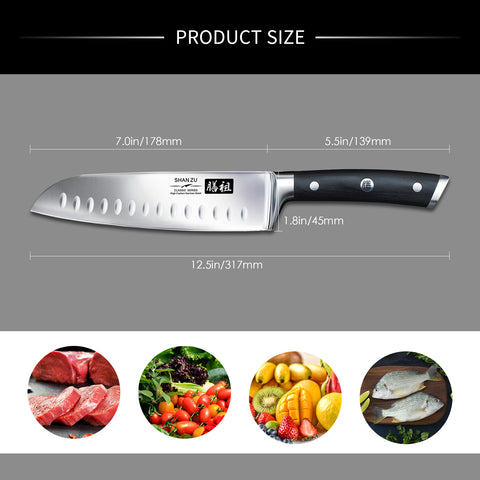
(1)Classic Series Santoku
Description
There is an engraved 膳 on the handle of every Classic Series which is a word connected with healthy diet. Santoku knife is a versatile all-purpose knife that can chop,slice and dice vegetables,meat and fish,with total ease.
Specs
Steel: German 1.4116 stainless steel at 55-57HRC
Edge: 15 Degrees per side using the traditional 3 step-Honbazuke method
Handle:Ergonomic Pakkawood
Bolster:Full bolster
Blade Length: 7 in. / 178mm
Total Length: 12.5 in. / 317 mm

(2)Pro Series Damascus Santoku
Description
There is an engraved 膳 on the handle of every Pro Series which is a word connected with healthy diet. Damascus Santoku is becoming more common in western kitchens.It has a wide variety of uses:meats,fish,and vegetables.
Specs
Steel:Ultra-premium Japanese AUS-10V steel core 33 outer layers of stainless steel on each side
Edge: 15 Degrees per side using the traditional 3 step-Honbazuke method
Handle:Material G10
Bolster:Full bolster
Pattern:Breathtaking Damascus Raindrop Pattern
Blade Length: 7 in. / 178mm
Total Length: 12.3 in. / 312 mm
(3)GYO Series Damascus Santoku
Description
GYO Series is the strikingly geometric design.It presents a look that is stylish and unique.There is an engraved 御 on the end cap of the GYO Series which means Honor in Japanese.Damascus Santoku is becoming more common in western kitchens.It has a wide variety of uses:meats,fish,and vegetables.
Specs
Steel:Ultra-premium Japanese AUS-10V steel core 33 outer layers of stainless steel on each side
Edge: 15 Degrees per side using the traditional 3 step-Honbazuke method
Handle:Material G10
Bolster:Full bolster
Pattern:Breathtaking Damascus Rolling wave pattern
Blade Length: 7 in. / 178mm
Total Length: 12.8 in. / 327 mm
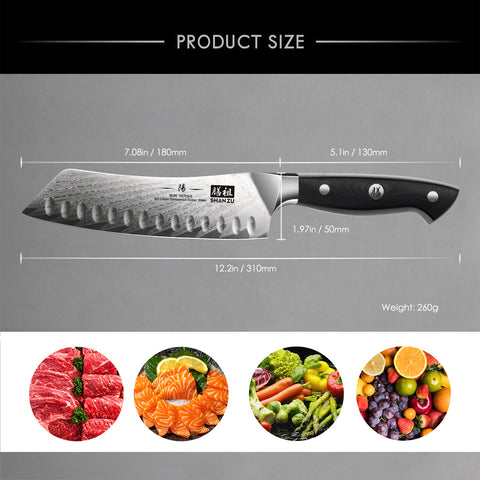
(4)SUN Series Damascus Santoku
Description
The pattern on the leaf is like the sun's rays, which is why we call "陽" -SUN SERIES.Damascus Santoku is becoming more common in western kitchens.It has a wide variety of uses:meats,fish,and vegetables.
Specs
Steel:Ultra-premium Japanese AUS-10V steel core 33 outer layers of stainless steel on each side
Edge: 15 Degrees per side using the traditional 3 step-Honbazuke method
Handle:Material G10
Bolster:Full bolster
Pattern:Breathtaking Damascus SUN Pattern
Blade Length: 7.08in. / 180mm
Total Length: 12.2 in. / 310 mm
7、Frequently Asked Questions About Chef’s Knives And Santoku Knives
(1)Chef’s Knives And Santoku Knives:Which should I choose?
Santoku knife and the Chef’s knife are the two of the most popular and versatile knives in the kitchen today. It’s a very common question to get, asking what the differences are and which is better…Santoku or chef knife?
Basically, the knife you choose will be based on your cooking preference and the knife will be the one that suits your grip best. The choose comes down to the personal preference and their habits with each knife. If you cook a specific type of food, for example a chicken/meat menu and involve in cutting some small bones as well as fruit and vegetables,then a Chef’s knife would be the better choice.If you are planning a menu with amount of fish,fruits and vegetables, but with less meat with bones, then a Santoku knife would be the wise choice. And if you’re spending a lot of time enjoying cooking in the kitchen , making a variety of dishes then it’s worth the money for both knives.
Normally,chef’s knives overall tend to be longer. Compared with smaller hands,those bigger hands may tend to like the Chef’s knife due to its bigger size. At the same time, smaller-handed folks may lean towards the Santoku knife for the same reason. You may find comfort in what you’ve been using also. But, we encourage everyone to try new things. If you’ve used the chef’s knife for years, give the Santoku a shot!
(2)What the differences in maintaining and sharpening for a Chef’s Knife and a Santoku Knife?
Knives should service you for a very long time provided you give them the right care which includes proper cleaning, sharpening and storage.
We highly recommend that use hand washing and dry knives with a soft, clean towel when use both of knives. Avoid using dishwashers and use a wooden box or block for storage the knives.
The difference in these two knives when it comes to the methods employed for sharpening.
For Chef’s Knives Sharpening:
As mentioned,when you need to create a defined and highly sharpened edge,you usually use the whetstone to sharpen a knife. It is a superior way to do it.Normally,sharpen a Chef’s Knife to 15 to 20 degrees on both sides.
You may also choose to use a honing steel to hone a Chef’s Knife.
For Santoku Knives Sharpening:
Due to the fact that Santoku knives normally only have a single bevel and are made from a harder steel, it is easier to create a sharpened edge. Generally, Santoku knives can be sharpened to an nearly angle of 10 – 15 degrees.
Because Santoku knives are generally do not have a bolser, so it is easier to sharpen. Single-bevel Santoku knife also require less sharpening work as opposed to double.
The most effective way to sharpen a Santoku is to use a whetstone. Whetstone sharpening gives a greater (sharper) knife edge than other methods.
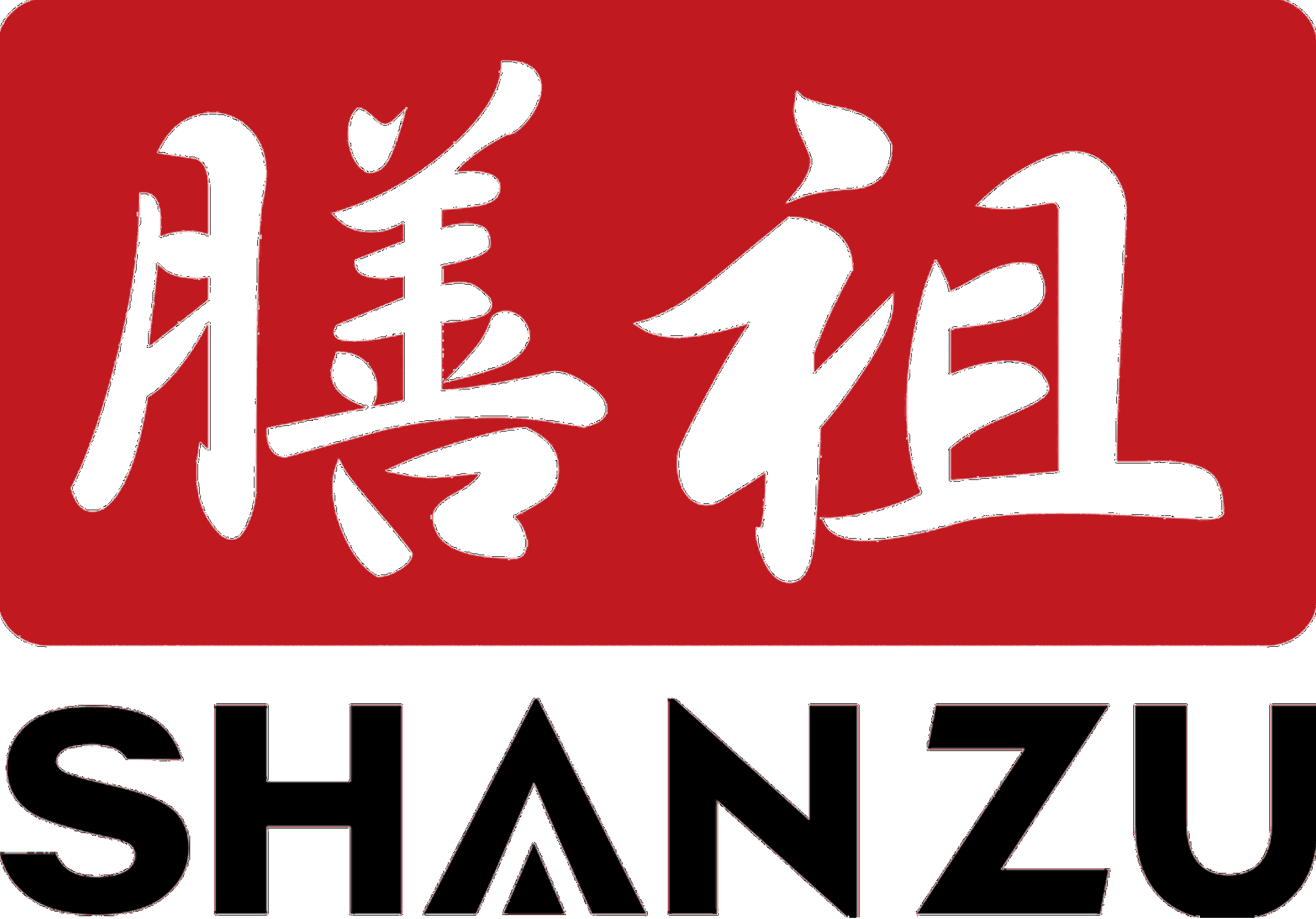
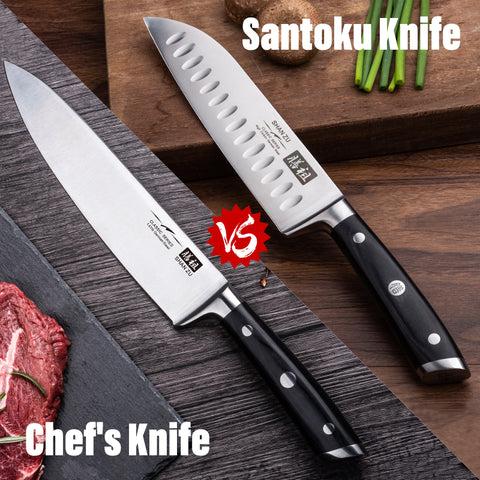
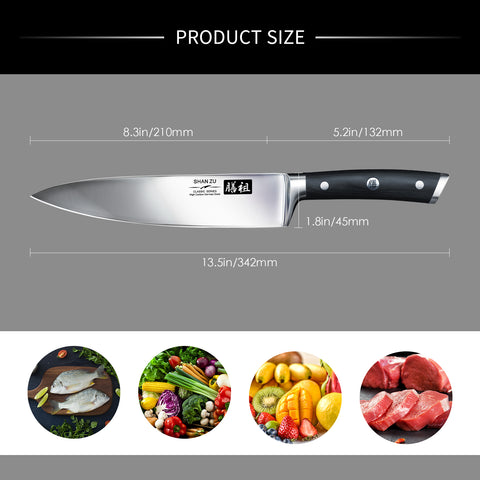
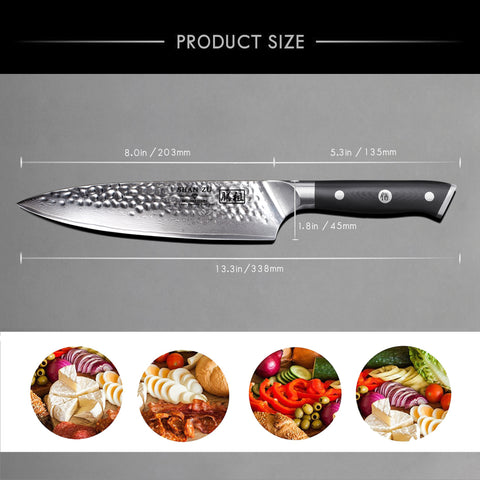

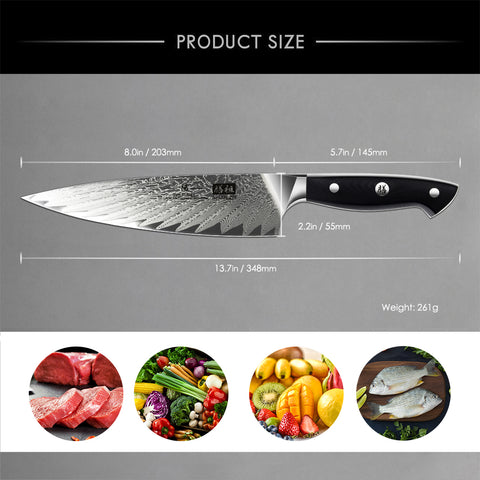




Commentaires (0)
Il n'y a pas de commentaires pour cet article. Soyez le premier à laisser un message !